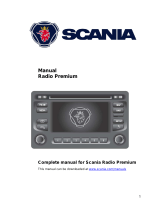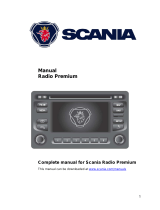Page is loading ...

To User
To User
Scania Higer A30, mounted with original SCANIA chassis, is a
newly developed deluxe coach.
The coach mainly runs on the high graded road and highway for
passenger transportation and tourism, etc.
This driver’s instruction contains operation, structure, specification
and maintenance of the coach body. You are kindly advised to read the
manual carefully for the correct operation and maintenance of your
coach.
In regard to the chassis instruction, please read the “Scania
Driver’s Instructions” and keep the operating instructions within the
vehicle.
Correct operation and maintenance can result in good
performance and longer service of the coach and lower operating
costs.
This driver’s instruction is edited on basis of the products before
delivery from the factory. Higer Bus Company Limited reserves the
right to modify the specification or change the parts or components of
this model at any time without modification of the delivered coaches.
In case of any questions or suggestions concerning our coaches,
you are welcome to provide feedback for our continuous improvement
of our products as well as better service to you.
Higer Bus Company Limited
June 2012

Catalog
Catalog
Vehicle Identification ............................................................. 1
Specification .......................................................................... 2
Body structure ....................................................................... 4
Driver’s area ......................................................................... 5
Passenger door ..................................................................... 6
Safety equipment ................................................................ 12
Rocker switch ...................................................................... 19
Driver’s seat ........................................................................ 29
Rear view mirror .................................................................. 32
Passenger area ................................................................... 34
Electronic clock ................................................................... 36
Microphone amplifier ........................................................... 39
DVD .................................................................................... 40
LCD ..................................................................................... 69
Reverse monitor .................................................................. 70
Air conditioning ................................................................... 72
Heating system ................................................................... 81
Defroster ............................................................................. 84
Electrical part ...................................................................... 87

Vehicle Identification
Vehicle Identification
Nameplate
The coach body nameplate is riveted on the RHS door entrance
panel of the front passenger door entrance.
1

Specification
Specification
Body
Parking on slope % ≥ 20
Passenger door - Out swing
Roof hatch 2
Window -
Double glazing front
windshield, the rest is
tempered glass
Electrical apparatus - 24V negative grounded
A/C system
Type -
Roof mounted condenser
and evaporator
Cooling power kw 30
Refrigerant - R134A
Inner
equipment
Media player
2

Specification
Inner
equipment
Front headlamps -
xenon headlamps/
halogen headlamps
Daylight lamp+ LED night
lamp
-
Floor leatheroid
-
domestic floor leatheroid
Composite floor
-
Guardrail - -
CAN -
3

Body structure
Body structure
1 Front fog lamp 6 Rear view mirror
2 Headlamp 7 Passenger door
3 Decoration panel 8 Front wheel
4 Windscreen wiper 9 Luggage compartment
5
Windscreen
10
Rear wheel
4

Driver’s area
Driver’s area
1 Rocker switch(Centre console) 12 Retarder control handle
2
Microphone amplifier
13
Gear selection button
3
Media player
14
Brake pedal
4
Reverse monitor
15
Accelerator pedal
5
Vent
16
Rocker switch(L-panel)
6
Rocker switch
17
Rear view mirror
control button
7
Combination switch
18
Microphone
8
Steering wheel
19
A/C control panel
9
Ignition switch
20
Parking brake
10
Instrument cluster
21
Driver’s seat
11 Rocker switch and Headlamp
knob
5

Passenger door
Passenger door
1. Mechanical lock
The mechanical lock is installed on the outside of front door panel.
Unlock the door
Rotate the lock cover by 180° to expose the key hole;
Insert the key and turn clockwise by 90°;
Turn the handle (with the key) clockwise by 90° and then
release it. The handle will automatically turns back by 90° and
the lock pin extends out;
Turn the key counterclockwise by 90° and then withdraw the
key;
Rotate the lock cover to cover the key slot.
Lock the door
Rotate the lock cover by 180° to expose the key hole;
Insert the key and turn clockwise by 90°;
Turn the handle (with the key) counterclockwise by 90° and then
release it. The handle will automatically turns back by 90° and
the lock pin extends out;
6

Passenger door
Turn the key counterclockwise by 90° and then withdraw the
key;
Rotate the lock cover to cover the key hole.
Caution:
Once the door is secured by the key, the electro-pneumatic
controls of the door are disabled.
2. Remote control
Press the button“ ” to unlock the door. Press the button” ” to
lock the door.
Replace the battery in the remote control when the indicator
light becomes dim or the control distance is reduced
drastically;
The upper buttons control the front passenger door, the lower
switch control the middle passenger door;
Each remote control is coded to ensure its uniqueness. Each
new coach is delivered equipped with two remote controls. If
7

Passenger door
they are lost, contact your Scania dealer.
If the coach is equipped with only the front passenger door, the
remote control will only contains the upper row buttons.
Note:
1) The remote control will only function when the handbrake is
applied or the air pressure in the system is within the normal
range.
2) The spare remote control should be kept in a safe location;
3) Do not throw or mishandle the remote controller
3. Rocker switch on dashboard
The battery master switch if turned on (by pressing the lower
edge) will connect to bulk of the electrical system to the battery.
The driver can control the door with the rocker switch on the
instrument cluster. “1” switch control the passenger door.
Press the upper or lower part of a rocker switch to open or shut
8

Passenger door
the door.
Warning:
1) Ensure that there is no obstacle before operating the
passenger door.
2) If the passenger door is obstructed by any person or objects
during closing, it will re-open automatically.
4. Emergency switch
Outer emergency switch
Position of the outside emergency switch of front door: The switch is
installed close to the front door;
Position of the outside emergency switch of middle door: The switch is
installed close to the middle door.
Operation:
In an emergency, rotate the red emergency knob clockwise to
release the air pressure in the pump. The door can then be
opened manually by pushing/pulling.
Reset the red emergency knob to its initial position before
9

Passenger door
reverting to the normal door control.
If the vehicle is not in use for extended period, turn on the
emergency switch. This will release the air pressure in the
pneumatic pipelines.
Inner emergency switch
Position of the inner emergency switch: The valve is installed above
the front or middle door in the coach.
Operation:
In an emergency, rotate the red emergency knob clockwise and
push open the door by hands.
Rotate the red emergency knob counterclockwise to its initial
position before reverting to normal control.
10

Passenger door
Note:
The rocker switch controlling the door on the dashboard and the
remote control will be disabled when the emergency switch is been
turned on.
11

Safety equipment
Safety equipment
1. Safety belt
Three point safety belt
Function of safety belt
Protect the driver and passengers in an emergency.
Operation:
1) Insert the tongue of the belt into the buckle at the cushion as
indicated in the above picture. A click sound will ensure that the tongue
is safely “locked” in the buckle.
2) To release, press the RED button at the side of the buckle as shown
in the above picture. This will unfasten the belt.
3) The three point belt should extend to the chest and hip instead of
12

Safety equipment
being under the arm or at the waist.
Note:
1) The seat belt should not be twisted.
2) Damaged seat belt should not be repaired but replaced.
3) Over inclination will prevent the seat belt from normal extension
or retraction.
2. Emergency switch of passenger door
In an emergency, turn the red emergency switch clockwise to
release the air pressure from the pump. The door can then be
pushed open by hand. Rotate the switch counterclockwise to its
initial position before reverting to the normal door control. (Refer to
the related passenger door for details)
Warning:
Do not operate the emergency switch other than during an
emergency, to avoid any injury.
13

Safety equipment
3. Emergency exit window
In an emergency, break the side window to escape.
As the centre part of the tempered glass window is tougher than the
edges, knock the edge, especially from the top middle, by directing the
hammer hitting tip at an angle. Continue hitting until cracks appear and
the glass is broken. The heels of female shoes can also be used for
the purpose, if there is a lack of hammers. The thinner the heel, the
more effective it will be in breaking the glass.
Note:
Check to ensure all the hammers are at the right positions before
driving each day.
14

Safety equipment
4. Portable fire extinguisher
Position:
There is one fire extinguisher in the bus, which is fixed on the edge of
step stripe beside the driver.
Operation:
1) Pull out the safety pin completely from the handle
2) Press the handle, directing nozzle towards the fire, to extinguish
the fire.
Note:
1) Ensure that the fire extinguisher is with a valid certificate.
2) Keep the nozzle away from the skin to avoid any injury;
3) Ensure that the fire extinguishers are secured at right positions
before operating the coach each day.
15

Safety equipment
5. Ceiling hatch
Without ventilator
Operation:
1. Push the black handle upwards to open one side of the roof
hatch for ventilation.
2. Pull the black handle downwards to close it.
3. In an emergency, pull the emergency handle away from the
hatch horizontally along the ceiling, until the elastic lock pins
release the roof hatch. Push open the hatch upwards for
passengers to escape.
16

Safety equipment
With ventilator
①Protruding handle ②Red handle
Operation:
1. Push the protruding handle upwards to open one side of the roof
hatch for ventilation.
2. Pull the protruding handle downwards to close it.
3. In an emergency, pull the red emergency handle downwards on
both sides and lift the hatch until it can be opened completely for
passengers to escape.
Warning:
Do not open the roof hatch completely unless during an
emergency.
②
①
17

Safety equipment
6. Using the correct amperage fuse
When replacing fuses, it is important not to use over-rated fuses as it
may cause overheating and fire.
18
/














